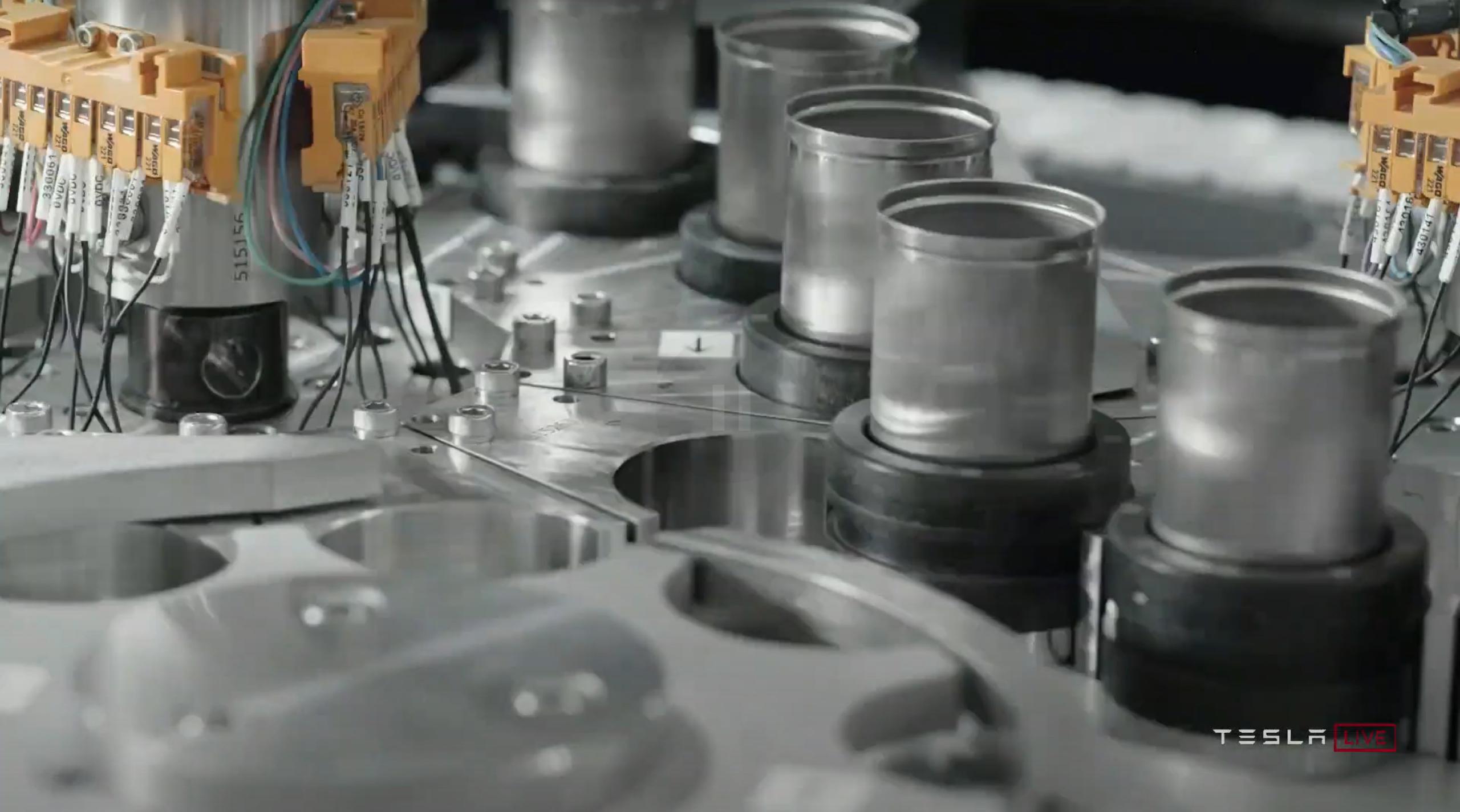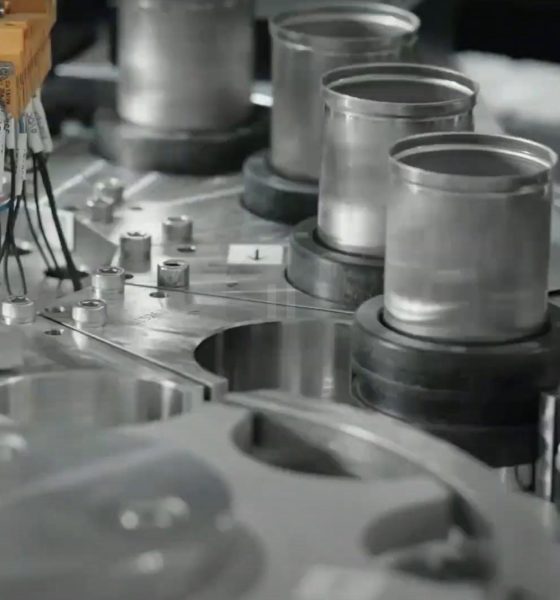Former Tesla 4680 battery cell production engineer James Herbermann has been named Vice President of Manufacturing at the American Battery Factory (ABF).
“James brings to American Battery Factory incredible perspective and front row experiences in evolving battery cell technology and is the perfect complement to our team as we begin our journey to develop a domestic battery manufacturing ecosystem that will make energy independence and renewable energy a reality for the United States,” ABF CEO and President Paul Charles said. “As we lay the foundation for our factory network, I am confident James’ cross-functional leadership will not only enhance the efficiency of ABF’s modular approach to manufacturing, but it will also propel our unwavering quest to develop the longest-lasting LFP prismatic battery cells on the market.”
James Herbermann, formerly with Tesla, joins American Battery Factory as its new Vice President of Manufacturing.
ABF is working to develop the United States’ first network of Lithium-Iron Phosphate, or LFP, battery cell gigafactories. The LFP cell is a major part of many automakers’ plans for future electric vehicles as more cell chemistries are being utilized to combat excessive demand. Tesla, for example, started transitioning its Standard Range trim levels to LFP batteries last year. The automaker confirmed that it would utilize the cell chemistry in lower range vehicle as they are less expensive and have longer lifespans. They do have their disadvantages, especially in terms of energy density, which means less power and range with EVs that utilize these packs. They are also more likely to be affected by adverse weather conditions, especially in colder climates.
CEO Elon Musk has said in the past that LFP packs want to be charged to 100 percent, as opposed to nickel-based packs that prefer a 90 percent state of charge.
Tesla is just one of the companies working to use LFP cells. Rivian, Ford, and Volkswagen are also utilizing the cell chemistry for some of their vehicles. Therefore, the need to produce more cells to provide automakers and customers with suitable options is definitely a work in progress.
Tesla (TSLA) Q1 2022 earnings results: Another beat with 19% operating profit and margin
ABF is working to eliminate LFP shortages with a series of production plants across the U.S., and the company is looking for Herbermann to lead and support all aspects of its manufacturing and production operations. Prior to ABF, Herbermann worked at Tesla to lead the development and scaling of its new battery electrode processes in Austin from the pilot program to a full-scale production process. He was a direct piece of Tesla’s commercialization of the 4680 cells, which has been installed in early builds of the Model Y from the new Austin factory. Additionally, Herbermann has developed “novel Sodium Titanium Phosphate; F1 racing Li-Ion cells; Aquion Hybrid Ion (AHI®); Duracell Ultra®; Comfort Plus® modular carpet tiles; and ZIP Wall® sheathing,” a press release from ABF said.
“I am inspired by ABF’s mission to develop a domestic supply chain for LFP batteries, especially in light of the pandemic’s crippling effect on availability and our country’s glaring void in battery cell manufacturing,” Herbermann said about his new role. “With its strategic approach of constructing a network of modular rapid construction factories near or onsite at pack integrators and energy solution providers, ABF is on track to solve one of the planet’s most pressing energy needs. I look forward to being a part of this impactful work.”
I’d love to hear from you! f you have any comments, concerns, or questions, please email me at joey@teslarati.com. You can also reach me on Twitter @KlenderJoey, or if you have news tips, you can email us at tips@teslarati.com.

News
Tesla (TSLA) receives “Buy” rating and $551 PT from Canaccord Genuity
He also maintained a “Buy” rating for TSLA stock over the company’s improving long-term outlook, which is driven by autonomy and robotics.

Canaccord Genuity analyst George Gianarikas raised his Tesla (NASDAQ:TSLA) price target from $482 to $551. He also maintained a “Buy” rating for TSLA stock over the company’s improving long-term outlook, which is driven by autonomy and robotics.
The analyst’s updated note
Gianarikas lowered his 4Q25 delivery estimates but pointed to several positive factors in the Tesla story. He noted that EV adoption in emerging markets is gaining pace, and progress in FSD and the Robotaxi rollout in 2026 represent major upside drivers. Further progress in the Optimus program next year could also add more momentum for the electric vehicle maker.
“Overall, yes, 4Q25 delivery expectations are being revised lower. However, the reset in the US EV market is laying the groundwork for a more durable and attractive long-term demand environment.
“At the same time, EV penetration in emerging markets is accelerating, reinforcing Tesla’s potential multi‑year growth runway beyond the US. Global progress in FSD and the anticipated rollout of a larger robotaxi fleet in 2026 are increasingly important components of the Tesla equity story and could provide sentiment tailwinds,” the analyst wrote.
Tesla’s busy 2026
The upcoming year would be a busy one for Tesla, considering the company’s plans and targets. The autonomous two-seat Cybercab has been confirmed to start production sometime in Q2 2026, as per Elon Musk during the 2025 Annual Shareholder Meeting.
Apart from this, Tesla is also expected to unveil the next-generation Roadster on April 1, 2026. Tesla is also expected to start high-volume production of the Tesla Semi in Nevada next year.
Apart from vehicle launches, Tesla has expressed its intentions to significantly ramp the rollout of FSD to several regions worldwide, such as Europe. Plans are also underway to launch more Robotaxi networks in several more key areas across the United States.
News
Waymo sues Santa Monica over order to halt overnight charging sessions
In its complaint, Waymo argued that its self-driving cars’ operations do not constitute a public nuisance, and compliance with the city’s order would cause the company irreparable harm.

Waymo has filed a lawsuit against the City of Santa Monica in Los Angeles County Superior Court, seeking to block an order that requires the company to cease overnight charging at two facilities.
In its complaint, Waymo argued that its self-driving cars’ operations do not constitute a public nuisance, and compliance with the city’s order would cause the company irreparable harm.
Nuisance claims
As noted in a report from the Los Angeles Times, Waymo’s two charging sites at Euclid Street and Broadway have operated for about a year, supporting the company’s growing fleet with round-the-clock activity. Unfortunately, this has also resulted in residents in the area reportedly being unable to sleep due to incessant beeping from self-driving taxis that are moving in and out of the charging stations around the clock.
Frustrated residents have protested against the Waymos by blocking the vehicles’ paths, placing cones, and “stacking” cars to create backups. This has also resulted in multiple calls to the police.
Last month, the city issued an order to Waymo and its charging partner, Voltera, to cease overnight operations at the charging locations, stating that the self-driving vehicles’ activities at night were a public nuisance. A December 15 meeting yielded no agreement on mitigations like software rerouting. Waymo proposed changes, but the city reportedly insisted that nothing would satisfy the irate residents.
“We are disappointed that the City has chosen an adversarial path over a collaborative one. The City’s position has been to insist that no actions taken or proposed by Waymo would satisfy the complaining neighbors and therefore must be deemed insufficient,” a Waymo spokesperson stated.
Waymo pushes back
In its legal complaint, Waymo stated that its “activities at the Broadway Facilities do not constitute a public nuisance.” The company also noted that it “faces imminent and irreparable harm to its operations, employees, and customers” from the city’s order. The suit also stated that the city was fully aware that the Voltera charging sites would be operating around the clock to support Waymo’s self-driving taxis.
The company highlighted over one million trips in Santa Monica since launch, with more than 50,000 rides starting or ending there in November alone. Waymo also criticized the city for adopting a contentious strategy against businesses.
“The City of Santa Monica’s recent actions are inconsistent with its stated goal of attracting investment. At a time when the City faces a serious fiscal crisis, officials are choosing to obstruct properly permitted investment rather than fostering a ‘ready for business’ environment,” Waymo stated.
News
Tesla FSD v14.2.2 is getting rave reviews from drivers
So far, early testers have reported buttery-smooth drives with confident performance, even at night or on twisty roads.

Tesla Full Self-Driving (Supervised) v14.2.2 is receiving positive reviews from owners, with several drivers praising the build’s lack of hesitation during lane changes and its smoother decision-making, among others.
The update, which started rolling out on Monday, also adds features like dynamic arrival pin adjustment. So far, early testers have reported buttery-smooth drives with confident performance, even at night or on twisty roads.
Owners highlight major improvements
Longtime Tesla owner and FSD user @BLKMDL3 shared a detailed 10-hour impression of FSD v14.2.2, noting that the system exhibited “zero lane change hesitation” and “extremely refined” lane choices. He praised Mad Max mode’s performance, stellar parking in locations including ticket dispensers, and impressive canyon runs even in dark conditions.
Fellow FSD user Dan Burkland reported an hour of FSD v14.2.2’s nighttime driving with “zero hesitations” and “buttery smooth” confidence reminiscent of Robotaxi rides in areas such as Austin, Texas. Veteran FSD user Whole Mars Catalog also demonstrated voice navigation via Grok, while Tesla owner Devin Olsen completed a nearly two-hour drive with FSD v14.2.2 in heavy traffic and rain with strong performance.
Closer to unsupervised
FSD has been receiving rave reviews, even from Tesla’s competitors. Xpeng CEO He Xiaopeng, for one, offered fresh praise for FSD v14.2 after visiting Silicon Valley. Following extended test drives of Tesla vehicles running the latest FSD software, He stated that the system has made major strides, reinforcing his view that Tesla’s approach to autonomy is indeed the proper path towards autonomy.
According to He, Tesla’s FSD has evolved from a smooth Level 2 advanced driver assistance system into what he described as a “near-Level 4” experience in terms of capabilities. While acknowledging that areas of improvement are still present, the Xpeng CEO stated that FSD’s current iteration significantly surpasses last year’s capabilities. He also reiterated his belief that Tesla’s strategy of using the same autonomous software and hardware architecture across private vehicles and robotaxis is the right long-term approach, as it would allow users to bypass intermediate autonomy stages and move closer to Level 4 functionality.










